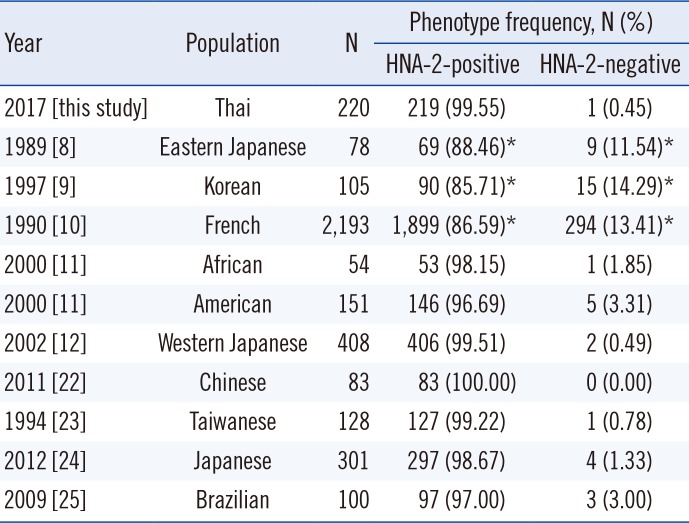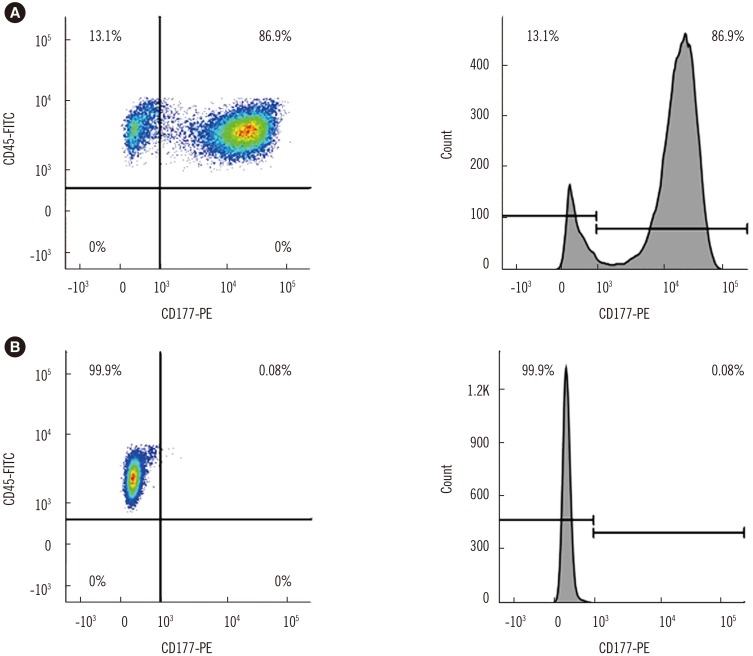1. Lalezari P, Murphy GB, Allen FH Jr. NB1, a new neutrophil-specific antigen involved in the pathogenesis of neonatal neutropenia. J Clin Invest. 1971; 50:1108–1115. PMID:
5552408.
2. Moritz E, Norcia AM, Cardone JD, Kuwano ST, Chiba AK, Yamamoto M, et al. Human neutrophil alloantigens systems. An Acad Bras Cienc. 2009; 81:559–569. PMID:
19722024.
3. Stroncek DF, Skubitz KM, McCullough JJ. Biochemical characterization of the neutrophil-specific antigen NB1. Blood. 1990; 75:744–755. PMID:
2153425.
4. Wolff J, Brendel C, Fink L, Bohle RM, Kissel K, Bux J. Lack of NB1 GP (CD177/HNA-2a) gene transcription in NB1 GP- neutrophils from NB1 GP-expressing individuals and association of low expression with NB1 gene polymorphisms. Blood. 2003; 102:731–733. PMID:
12623849.
5. Flesch BK. Human neutrophil antigens: a nomenclature update based on new alleles and new antigens. VOXS. 2015; 10(S1):243–249.
6. Muschter S, Berthold T, Greinacher A. Developments in the definition and clinical impact of human neutrophil antigens. Curr Opin Hematol. 2011; 18:452–460. PMID:
21912255.
7. Kissel K, Scheffler S, Kerowgan M, Bux J. Molecular basis of NB1 (HNA-2a, CD177) deficiency. Blood. 2002; 99:4231–4233. PMID:
12010833.
8. Ohto H, Matsuo Y. Neutrophil-specific antigens and gene frequencies in Japanese. Transfusion. 1989; 29:654.
9. Han KS. Frequency of neutrophil-specific antigens among Koreans using the granulocyte indirect immunofluorescence test (GIFT). Immunohematology. 1997; 13:15–16. PMID:
15387793.
10. Bierling P, Poulet E, Fromont P, Seror T, Bracq C, Duedari N. Neutrophil-specific antigen and gene frequencies in the French population. Transfusion. 1990; 30:848–849. PMID:
1700502.
11. Matsuo K, Lin A, Procter JL, Clement L, Stroncek D. Variations in the expression of granulocyte antigen NB1. Transfusion. 2000; 40:654–662. PMID:
10864984.
12. Taniguchi K, Kobayashi M, Harada H, Hiraoka A, Tanihiro M, Takata N, et al. Human neutrophil antigen-2a expression on neutrophils from healthy adults in western Japan. Transfusion. 2002; 42:651–657. PMID:
12084175.
13. Wolff JC, Goehring K, Heckmann M, Bux J. Sex-dependent up regulation of CD 177-specific mRNA expression in cord blood due to different stimuli. Transfusion. 2006; 46:132–136. PMID:
16398742.
14. Taniguchi K, Nagata H, Katsuki T, Nakashima C, Onodera R, Hiraoka A, et al. Significance of human neutrophil antigen-2a (NB1) expression and neutrophil number in pregnancy. Transfusion. 2004; 44:581–585. PMID:
15043575.
15. Stroncek DF, Jaszcz W, Herr GP, Clay ME, McCullough J. Expression of neutrophil antigens after 10 days of granulocyte-colony-stimulating factor. Transfusion. 1998; 38:663–668. PMID:
9683105.
16. Gohring K, Wolff J, Doppl W, Schmidt KL, Fenchel K, Pralle H, et al. Neutrophil CD177 (NB1 gp, HNA-2a) expression is increased in severe bacterial infections and polycythaemia vera. Br J Haematol. 2004; 126:252–254. PMID:
15238147.
17. Passamonti F, Pietra D, Malabarba L, Rumi E, Della Porta MG, Malcovati L, et al. Clinical significance of neutrophil CD177 mRNA expression in Ph-negative chronic myeloproliferative disorders. Br J Haematol. 2004; 126:650–656. PMID:
15327515.
18. Matsuhashi M, Tsuno NH, Iino J, Nagura Y, Okazaki H, Santoso S. Advances in granulocyte test methodologies. ISBT Sci Ser. 2014; 9:246–252.
19. Li Y, Mair DC, Schuller RM, Li L, Wu J. Genetic mechanism of human neutrophil antigen 2 deficiency and expression variations. PLoS Genet. 2015; 11:e1005255. PMID:
26024230.
20. Moritz E, Chiba AK, Kimura EY, Albuquerque D, Guirão FP, Yamamoto M, et al. Molecular studies reveal that A134T, G156A and G1333A SNPs in the CD177 gene are associated with atypical expression of human neutrophil antigen-2. Vox Sang. 2010; 98:160–166. PMID:
19695014.
21. Bayat B, Bein G, Sachs UJ. A sequence-specific polymerase chain reaction method for HNA-2 genotyping: homozygous c.843A>T mutation predicts the absence of CD177. Transfusion. 2016; 56:2127–2132. PMID:
27385476.
22. Xia W, Bayat B, Sachs U, Chen Y, Shao Y, Xu X, et al. The frequencies of human neutrophil alloantigens in the Chinese Han population of Guangzhou. Transfusion. 2011; 51:1271–1277. PMID:
21166683.
23. Lin M, Chen CC, Wang CL, Lee HL. Frequencies of neutrophil-specific antigens among Chinese in Taiwan. Vox Sang. 1994; 66:247. PMID:
7518626.
24. Matsuhashi M, Tsuno NH, Kawabata M, Mishima Y, Okochi N, Santoso S, et al. The frequencies of human neutrophil alloantigens among the Japanese population. Tissue Antigens. 2012; 80:336–340. PMID:
22776008.
25. Norcia AM, Sugano EY, Chiba AK, Moritz E, Guirao FP, Yamamoto M, et al. Human neutrophil alloantigen-1a, -1b, -2, -3a and -4a frequencies in Brazilians. Tissue Antigens. 2009; 74:404–407. PMID:
19737365.
26. Hulspas R, O'Gorman MR, Wood BL, Gratama JW, Sutherland DR. Considerations for the control of background fluorescence in clinical flow cytometry. Cytometry B Clin Cytom. 2009; 76:355–364. PMID:
19575390.
27. Caruccio L, Walkovich K, Bettinotti M, Schuller R, Stroncek D. CD177 polymorphisms: correlation between high-frequency single nucleotide polymorphisms and neutrophil surface protein expression. Transfusion. 2004; 44:77–82. PMID:
14692971.
28. Changsri K, Tobunluepop P, Songthammawat D, Apornsuwan T, Kaset C, Nathalang O. Human neutrophil alloantigen genotype frequencies in Thai blood donors. Blood Transfus. 2014; 12:s286–s291. PMID:
23399362.






 PDF
PDF ePub
ePub Citation
Citation Print
Print



 XML Download
XML Download